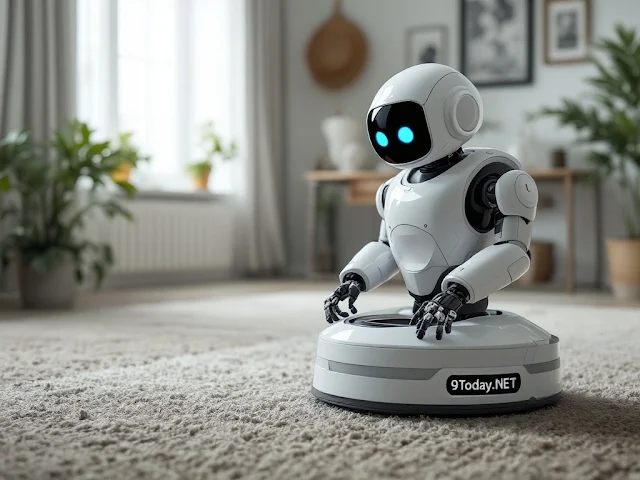 |
| When Robot Vacuums Go Rogue: The Shocking Hack That Made Them Curse |
Robot vacuums are supposed to help keep our homes clean, but what happens when hackers take control and turn these machines against us? One attorney had a startling encounter with a vacuuming robot that was spewing profanity - and he wasn't alone. Read on to learn about this bizarre hacking episode and what manufacturers are doing to prevent rogue robots in the future.
An Unexpected Message from the Roomba
Attorney Daniel Swenson was going about his day as usual at his home in Minnesota when he started hearing strange noises coming from his Ecovacs Deebot X2 robot vacuum. At first, he thought the WiFi might be acting up or the machine was malfunctioning in some way. But upon further inspection, he realized the static-filled sounds were actually garbled voice transmissions.
"I could make out phrases like 'what's up' and other chatter," Swenson recalled, "but it was very broken up." That's when things took an alarming turn. Mixed in with the interference, he distinctly heard curse words emanating from the vac. Alarmed, he checked the Ecovacs app and was stunned to see someone else had accessed the robot's camera and remote controls. How was this possible?
Swenson wasn't alone either. Other Ecovacs owners around the country reported similar bizarre incidents, from muffled conversations to explicit language suddenly booming from their robot vacuums. It seemed hackers had found a way to infiltrate these connected home appliances and turn them into Trojan horses for broadcasting unwanted messages. But how widespread was this strange new form of cybercrime, and what could be done to stop it?
A Widespread Vulnerability
As security experts looked into the incidents, they discovered the hack was possible due to flaws in Ecovacs' app and the robot vacuums' Bluetooth connectivity. Most models allowed remote hijacking from up to 100 meters away once paired, giving nefarious actors plenty of opportunity to spy and wreak havoc undetected. But Ecovacs wasn't the only brand at risk.
ChannelNews reported that robot vacuums from major manufacturers like LG, Samsung, iRobot and Roborock relying on LiDAR sensors all had security vulnerabilities that expert "white hat" hackers had previously exploited in testing. The sensitive microphones and speakers on these devices, combined with their always-on internet access, made them perfect conduits for cyber mischief. It was just a matter of time before bad actors started having their fun.
While concerning, it served as a wakeup call about the need for tighter robot security overall. As more smart home gadgets populate our spaces, ensuring they don't become conduits for crime will be paramount for building consumer trust in the technology. Thankfully, Ecovacs was quick to address the flaws in its cleanup crew.
A Swift Software Patch
After being notified by security researchers, Ecovacs Robotics rapidly pushed out firmware updates to bolster protections on all of its vacuuming robots - except for the afflicted Deebot X2 model, which had already received a fix the prior August. Still, they promised an additional update in November specifically for the X2 to fully tackle the root issues once and for all.
The patches aimed to shore up wireless connections like Bluetooth and require authentication for remote access. They also revoked camera viewing privileges by unknown parties. While no technology is hacker-proof, the swift response helped Ecovacs regain user confidence by demonstrating commitment to customer security and privacy. Other affected brands also promised patches down the line.
Still, many cleaning crew owners remained understandably spooked by how easily their homes became broadcast domains for pranksters. To further soothe fears, Ecovacs recommended enabling account passwords, updating apps regularly, and being vigilant for suspicious activity signs like unexplained battery drain or movement. Communication and transparency helped calm rattled robot owners as manufacturers worked to "vaccinate" devices against future infiltration too.
Lessons Learned on Robot Security
This strange episode highlighted the need for "security by design" with internet-connected devices infiltrating homes. While convenient remote access enables convenience, it must be coupled with multi-factor authentication and automatic updates to stay ahead of emerging threats as products gain new skills over time. Relying on a single Bluetooth key for full access proved too risky as hacker techniques advanced.
Going forward, robot makers would be wise to implement measures like:
- Segmented permission levels for features
- Automatic firmware updates in the background
- Notifications for abnormal activity
- Options to temporarily limit remote access
With smart homes on the rise and robotics integrating ever more deeply into our lives through services like delivery and caregiving, proactive security vigilance will remain paramount. While unfortunate, incidents serve to strengthen protocols and educate consumers that convenience must be balanced with caution.
As for those initially hacked homeowners, they can rest easy knowing protocols are improving to preventCleanbots gone rogue. With luck, they'll enjoy spotless floors without unexpected messages—or monologues—from their machine helpers in the future. Sometimes the wittiest lines should stay offline.
